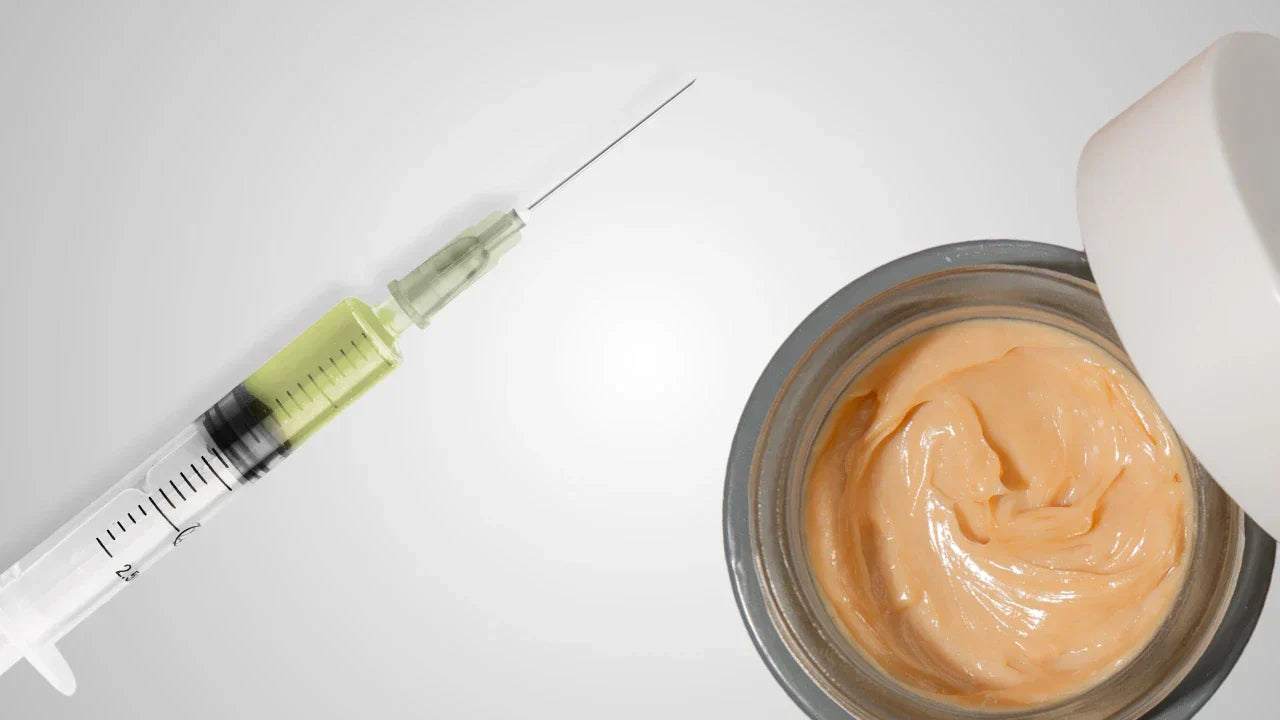If you've ever experienced nerve pain, you know it's unlike any other discomfort. That burning, shooting, electric-like sensation can stop you in your tracks and make even the simplest daily activities feel impossible. I've spoken with countless patients who describe it as "feeling like my skin is on fire" or "like someone's stabbing me with tiny needles." Nerve pain isn't just physically debilitating; it can take an emotional toll as well.
In this comprehensive guide, we'll explore how topical treatments can help manage neuropathic pain, comparing prescription options with over-the-counter solutions. We'll discuss various nerve creams for nerve pain, including specialized nerve cream for feet conditions. By the end, you'll have a clearer understanding of which option might work best for your particular situation.
Understanding Nerve Pain: More Than Just a Symptom
Nerve pain (neuropathic pain) represents a distinct category of pain that stems from problems with the nerves themselves rather than tissue damage. This fundamental difference explains why treatments that work wonderfully for a sprained ankle or muscle soreness might do absolutely nothing for nerve pain.
What Actually Happens When Nerves Hurt?
To truly understand nerve pain, we need to look at what's happening on a physiological level. Your nervous system is essentially your body's electrical wiring—it transmits signals between your brain and every part of your body. When nerves become damaged or dysfunctional, they can send incorrect pain signals to your brain, even when there's no actual threat or injury present.
Think of it like this: if regular pain is like an accurate alarm system that alerts you to a problem (like touching a hot stove), nerve pain is like a faulty alarm that keeps blaring even when there's no fire. Your brain receives these distress signals and interprets them as pain, even though there might not be any ongoing damage.
Common Causes of Nerve Pain
Nerve pain doesn't discriminate—it can affect anyone regardless of age or background. Here are some of the most common causes:
- Diabetes (Diabetic Neuropathy): High blood sugar levels can damage nerves, particularly in the feet and hands. According to the American Diabetes Association, about 50% of people with diabetes will develop some form of neuropathy. Many patients find that cream for feet neuropathy provides targeted relief for this common condition.
- Shingles (Postherpetic Neuralgia): After a shingles outbreak subsides, some people continue to experience nerve pain that can last for months or even years. This persistent pain occurs in approximately 10-18% of people who develop shingles, with risk increasing with age.
- Nerve Compression or Injury: Physical trauma, repetitive motions, or conditions like carpal tunnel syndrome can damage nerves, leading to pain along the affected nerve pathway.
- Multiple Sclerosis: This autoimmune condition damages the protective covering of nerves (myelin), which can result in various symptoms including neuropathic pain.
- Chemotherapy-Induced Peripheral Neuropathy (CIPN): Certain cancer treatments can damage peripheral nerves, leading to pain, numbness, and tingling, typically in the hands and feet. Studies suggest that 30-40% of cancer patients receiving chemotherapy experience some degree of CIPN.
- HIV/AIDS: The virus itself or medications used to treat it can cause neuropathy in some patients.
- Vitamin Deficiencies: Particularly B-vitamins, which are crucial for nerve health.
- Idiopathic Neuropathy: In about 30% of cases, doctors can't identify a specific cause. These unexplained cases can be particularly frustrating for patients seeking answers.
The Unique Sensations of Nerve Pain
One of the challenges in diagnosing and treating nerve pain is its diverse presentation. People describe their symptoms in vastly different ways:
- Burning sensations that seem to come from deep within
- Sharp, electric shock-like pains that come and go
- Constant tingling or "pins and needles"
- Extreme sensitivity to touch (even light contact with clothing can be painful)
- Feelings of numbness paradoxically combined with pain
- Pain in response to non-painful stimuli (like cold temperatures)
Many people find that their nerve pain worsens at night, disrupting sleep and creating a vicious cycle where sleep deprivation further intensifies pain perception. This nighttime exacerbation often occurs because there are fewer distractions, and your brain has more capacity to process pain signals. Finding the best cream for nerve pain that provides lasting relief through the night can be particularly valuable for improving sleep quality.
Over-the-Counter Creams for Nerve Pain
For those just beginning to explore treatment options, over-the-counter nerve creams offer an accessible starting point. These neuropathic cream products don't require a prescription and can be found at most pharmacies and grocery stores. But how effective are they, and which ingredients should you look for?

Key Ingredients in OTC Nerve Pain Creams
When shopping for OTC creams, you'll encounter several common active ingredients. Understanding how each works can help you make a more informed choice:
Capsaicin: The Hot Pepper Extract
Derived from chili peppers, capsaicin might seem counterintuitive as a pain reliever—after all, it's the same compound that makes peppers spicy! However, it works through a fascinating mechanism:
When applied topically, capsaicin initially activates the TRPV1 receptors in your skin, creating a warming sensation. With continued use, it depletes substance P, a neurotransmitter responsible for sending pain signals to your brain. Through this process of "desensitization," pain messages are reduced over time.
Products containing capsaicin typically come in different strengths, ranging from 0.025% to 0.1% in OTC formulations. Be prepared for the initial burning sensation, which paradoxically indicates the product is working. Many users report that this sensation diminishes with regular application over 1-2 weeks.
A 2017 review published in the British Journal of Anesthesia found that high-concentration capsaicin treatments provided meaningful pain relief for conditions including postherpetic neuralgia and HIV-associated neuropathy. However, OTC concentrations are significantly lower than those used in clinical studies.
Pro tip: Apply capsaicin creams with a glove or applicator and wash your hands thoroughly afterward to avoid accidental transfer to sensitive areas like eyes or mucous membranes.
Lidocaine: Temporary Numbing Relief
Lidocaine functions as a local anesthetic by blocking sodium channels in nerve cells, preventing them from transmitting pain signals. OTC lidocaine products typically contain concentrations between 4-5%.
The advantage of lidocaine is its rapid onset—you'll usually feel relief within minutes of application. The downside is that this relief is temporary, typically lasting 1-3 hours. These products come in various forms including creams, patches, sprays, and gels.
Lidocaine is particularly helpful for localized pain in small areas, making it popular for conditions like postherpetic neuralgia or focal nerve injuries. It's also frequently included in nerve cream for feet formulations, as the thin skin on feet allows for better absorption. Unlike capsaicin, lidocaine doesn't cause an initial burning sensation, making it more immediately tolerable for many users.
Menthol and Camphor: The Cooling Distraction
These ingredients work primarily through a mechanism called "counter-irritation." When you apply a menthol or camphor product, the cooling or warming sensation essentially distracts your brain from focusing on the underlying nerve pain. It's similar to how rubbing your elbow after bumping it provides momentary relief.
Menthol activates the TRPM8 receptors in your skin, creating a cooling sensation without actually lowering skin temperature. Camphor produces a warming effect through different receptors. Both create sensations strong enough to partially override pain signals being sent to your brain.
Products containing these ingredients often provide immediate sensory relief but don't address the underlying mechanisms of nerve pain. They're especially useful for temporary relief while waiting for other treatments to take effect.
Limitations of OTC Options
While over-the-counter nerve creams can provide meaningful relief for some people, it's important to understand their limitations:
- Symptom Focus: Most OTC creams address the symptoms rather than the underlying causes of nerve pain.
- Surface-Level Action: Many OTC ingredients don't penetrate deeply enough to reach damaged nerves, particularly in conditions affecting deeper tissues.
- Limited Potency: OTC products contain lower concentrations of active ingredients compared to prescription alternatives.
- Short Duration: Relief from OTC products typically lasts for just a few hours, requiring frequent reapplication.
- Effectiveness Ceiling: For moderate to severe neuropathic pain, OTC options alone may not provide adequate relief.
Many people find that OTC nerve creams for nerve pain work best as part of a comprehensive pain management approach rather than as a standalone solution. They can be particularly valuable for breakthrough pain or for use during activities that tend to aggravate symptoms.
Prescription Creams for Nerve Pain: When OTC Isn't Enough
When over-the-counter options fail to provide adequate relief, prescription neuropathic cream treatments offer the next level of intervention. These medications typically contain higher concentrations of active ingredients or utilize compounds not available over the counter. For many patients seeking the best cream for nerve pain, prescription options may provide more substantial relief.
High-Concentration Lidocaine
Prescription lidocaine patches (like Lidoderm) contain 5% lidocaine—slightly higher than most OTC products. However, the real advantage comes from the delivery system. These patches are designed to release the medication gradually over 12 hours, providing substantially longer relief than OTC alternatives.
Clinical studies have shown that lidocaine patches can reduce pain intensity by 30-50% in conditions like postherpetic neuralgia. The patches can be cut to fit the affected area and are particularly useful for well-defined pain regions.
Unlike many oral medications, topical lidocaine has minimal systemic absorption, reducing the risk of side effects or drug interactions. This makes it a valuable option for older adults or those taking multiple medications.
Compounded Prescription Creams
One of the major advantages of prescription options is the ability to create customized formulations tailored to your specific type of nerve pain. Compounding pharmacists can prepare nerve creams containing combinations of:
- Amitriptyline: A tricyclic antidepressant that modulates pain signals when applied topically
- Ketamine: An anesthetic that blocks NMDA receptors involved in nerve pain
- Gabapentin: An anti-seizure medication that can help stabilize overactive nerves
- Baclofen: A muscle relaxant that can help with nerve pain associated with spasticity
- Clonidine: Originally a blood pressure medication that has shown effectiveness for certain types of neuropathy when applied topically
- Higher concentrations of OTC ingredients: Such as 8% lidocaine or stronger menthol formulations
These custom-compounded creams allow for targeted treatment of specific pain mechanisms. For example, a cream containing both ketamine and gabapentin might be prescribed for someone with both shooting and burning pain components. For diabetic patients, specialized cream for feet neuropathy formulations can be created with ingredients that address the unique aspects of diabetic nerve pain.
Dr. Jennifer Martin explains: "Compounded creams allow us to address multiple pain pathways simultaneously. For complex neuropathic pain, this multi-modal approach often yields better results than single-ingredient treatments."
Diclofenac and Other Prescription NSAIDs
For nerve pain with an inflammatory component, prescription-strength topical NSAIDs like diclofenac gel (Voltaren) may be prescribed. These work by inhibiting the production of prostaglandins, the compounds involved in inflammation and pain signaling.
While NSAIDs aren't typically first-line treatments for pure neuropathic pain, they can be helpful when nerve pain coexists with inflammatory conditions. The prescription versions offer higher concentrations than OTC alternatives and may provide better relief for deeper tissues.
The Prescription Advantage: Medical Oversight
Perhaps the greatest benefit of prescription options isn't just the medications themselves but the medical guidance that accompanies them. Working with a healthcare provider means:
- Regular assessment of treatment effectiveness
- Monitoring for side effects or interactions
- Adjustment of treatment plans as needed
- Integration with other pain management approaches
- Access to newer treatments as they become available
This ongoing relationship with a healthcare provider is invaluable, especially for chronic pain conditions that may require management over many years.
Nerve Balm: Supporting Nerve Health Rather Than Just Masking Pain
While traditional approaches focus primarily on blocking pain signals, newer products like Nerve Balm take a fundamentally different approach. Instead of just numbing the area, these specialized nerve creams aim to support nerve health and address some of the underlying factors contributing to nerve pain.
The Blood Flow Connection
One of the most intriguing aspects of Nerve Balm is its focus on improving circulation to affected nerves. This approach recognizes a crucial fact that's often overlooked in pain management: healthy nerves require adequate blood flow.
Your nerves are living tissue with high metabolic demands. They require a constant supply of oxygen and nutrients to function properly and repair themselves. When this supply is compromised—whether from diabetes, compression, inflammation, or other causes—nerves essentially begin to starve, leading to dysfunction and pain.
As one patient described it: "It's like my nerves are screaming for help because they're not getting what they need."
Nerve Balm contains vasodilators that help expand blood vessels in the application area, potentially increasing the delivery of oxygen and nutrients to damaged nerves. This approach aligns with research showing that impaired microcirculation is a contributing factor in several neuropathic conditions, including diabetic neuropathy.
Multi-Modal Action
What sets Nerve Balm apart from many traditional creams is its multi-faceted approach:
- Vasodilation: Ingredients that help expand blood vessels to improve circulation to nerve tissue
- Pain Receptor Modulation: Compounds that interact with pain receptors to reduce discomfort without completely numbing the area
- Deep Penetration: Formulated to reach deeper tissues where nerve damage often occurs
- Anti-inflammatory Action: Components that help reduce inflammation, which can compress nerves and worsen pain
- Nerve Insulation Support: Nutrients that support myelin, the protective covering around nerves that's often damaged in neuropathic conditions
This comprehensive approach acknowledges that nerve pain is complex and often requires addressing multiple factors simultaneously.
The Fire Alarm Analogy
To understand the difference between Nerve Balm and conventional treatments, consider this analogy:
Imagine your nerve pain as a fire alarm. Traditional numbing treatments essentially disable the alarm without addressing the fire itself. While this provides temporary relief (silence), the underlying problem continues to smolder.
Nerve Balm, on the other hand, aims to help extinguish the fire by giving your nerves what they need to function properly. It's the difference between unplugging a smoke detector and actually putting out the flames.
As Barbara Flannery, whose husband is a long-term user of Nerve Balm for neuropathy, explains: "My husband has peripheral neuropathy and we've tried every cream out there - this is, by far, the best he's ever had! This balm, coupled with the super-cute diabetic socks I got him (yes, I found them on Amazon!), he's moving and shaking! The numbness and tingle is not *totally* gone, but I would say 90% is; of course, if it's damp out, rainy or snow, that's a different story and to be expected, but with this balm, he's walking normally, with the return of a pep in his step! I'm so glad I found you, I can't thank you enough!"
Making an Informed Decision: Finding Your Best Option
With so many options available, how do you determine which approach is right for you? Here's a framework to help guide your decision:
Consider the Severity of Your Pain
The intensity and impact of your pain should influence your treatment approach:
- Mild pain that's more annoying than debilitating might respond well to OTC options
- Moderate pain that affects daily activities may require prescription-strength treatments
- Severe pain often needs a multi-modal approach, potentially combining topical treatments with oral medications and other therapies
Identify Your Pain Characteristics
The nature of your pain can help determine which ingredients might work best:
- Burning pain often responds to treatments containing menthol or lidocaine
- Shooting, electric-like pain might benefit from compounds that stabilize nerve membranes, like those in some prescription nerve creams
- Pain with inflammatory components may improve with anti-inflammatory ingredients
- Foot pain typically responds well to specially formulated nerve cream for feet that takes into account the unique skin characteristics of this area
Factor in Your Overall Health
Your existing health conditions and medications matter:
- Diabetic neuropathy patients often benefit from treatments supporting circulation
- People taking multiple medications might prefer topical treatments to avoid additional drug interactions
- Those with sensitive skin should start with gentler formulations and patch-test new creams
Consider Practical Aspects
Practical considerations can impact treatment success:
- Application frequency: Can you realistically apply a cream multiple times daily?
- Cost and insurance coverage: Prescription options may be covered by insurance, while OTC and alternative treatments typically aren't
- Application area: Larger affected areas might benefit from patches or less expensive options
The Importance of a Comprehensive Approach
While topical treatments can provide significant relief, they're often most effective when combined with other pain management strategies:
- Physical therapy to improve strength and mobility
- Stress management techniques like meditation, as stress can amplify pain perception
- Proper nutrition including B-vitamins and alpha-lipoic acid, which support nerve health
- Adequate sleep to help regulate pain processing
- Activity modification to avoid aggravating painful areas
When to See a Doctor
While exploring topical treatments, certain situations warrant prompt medical attention:
- New or worsening nerve pain without an obvious cause
- Severe pain that significantly impacts your quality of life
- Pain accompanied by muscle weakness, which may indicate more serious nerve damage
- Rapidly progressing symptoms
- Pain that doesn't respond to over-the-counter treatments
- Development of skin reactions to topical treatments
A healthcare provider can properly diagnose the cause of your nerve pain and help develop a comprehensive treatment plan. They can also monitor for complications and adjust treatments as needed
Final Thoughts: Hope for Those with Nerve Pain
Living with nerve pain can be challenging, but the growing array of treatment options offers hope. From readily available OTC creams to prescription-strength formulations and innovative approaches like Nerve Balm, there are more ways than ever to manage neuropathic pain. Finding the best cream for nerve pain may take some trial and error, but relief is possible.
Remember that finding the right solution often requires patience and persistence. What works for one person may not work for another, and you might need to try several approaches before finding your optimal treatment. For those with foot neuropathy specifically, specialized nerve cream for feet formulations may provide more targeted relief due to their specific formulation for the unique skin characteristics of the feet.
As someone who has both studied neuropathic pain and worked with patients experiencing it, I encourage you not to lose hope. Advances in our understanding of nerve pain continue to lead to better treatments, and many people do find significant relief with the right approach.
Work closely with healthcare providers, be open to different treatment modalities, and remember that even small improvements in pain levels can substantially enhance your quality of life. With the right combination of treatments and strategies, many people with nerve pain can return to activities they love and reclaim a sense of normalcy in their daily lives.
Disclaimer: This article is for informational purposes only and does not constitute medical advice. Always consult with a qualified healthcare provider before starting any new treatment for nerve pain.






